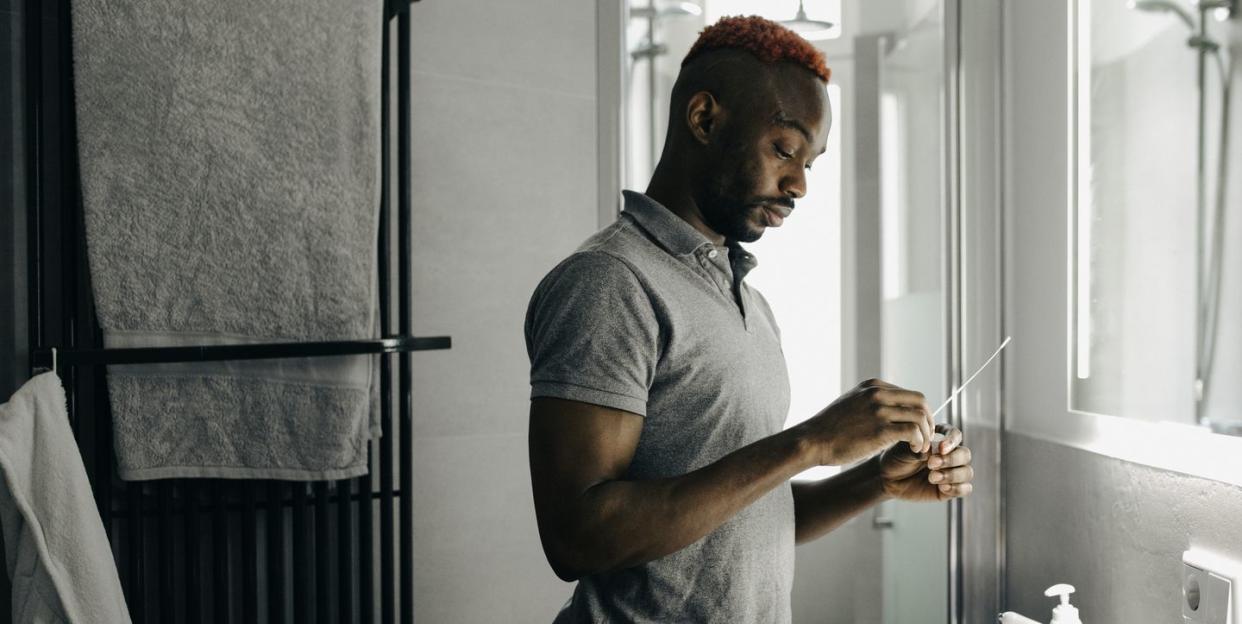Everything You Need to Know About At-Home Covid Tests

At the beginning of the pandemic, it was hard to know if you had Covid, since tests were scarce. Lines were long, testing sites were few, equipment was hard to come by. Testing has come a long way since then.
Now, not only are there more testing sites doing PCR tests, the more-accurate method that requires a sample to be sent off to a lab for analysis, you can even do a home PCR test (you still have to send it off to a lab).
The other type of test—rapid antigen tests—are being done routinely at people-heavy areas including workplaces and concerts. There are now a number of at-home rapid tests you can buy over the counter that give you results right on the spot without stepping out your door.
Just how accurate are these rapid at-home tests?
Rapid at-home tests are antigen tests; they look for fragments of proteins from the virus to see if you’re infected with it. PCR tests look for genetic material of the virus itself. At home, you can’t yet do what a PCR test does. The PCR test has an amplification step, explains Gigi Gronvall, a senior scholar at the Johns Hopkins Center for Health Security who’s been tracking rapid tests. “So it can magnify very weak signals and be able to tell if someone’s infected.”
With rapid antigen tests, you have to have a significant amount of virus in your nose for it to register. If you take the test at the right time, these tests can be accurate—"they’re just most accurate when people are actively infectious with SARS CoV-2,” she says.
In general, these at-home tests are more accurate at confirming that you have Covid than they are at confirming that you don’t. In practical terms, that means you need to be more skeptical of a negative result than a positive one.
The three main rapid antigen tests authorized by the FDA now each claim different accuracy rates:
BinaxNow, by Abbott Laboratories
The BinaxNow test is reported to agree with positive PCR tests 84.6% of the time and negative ones 98.5% of the time. You swab and place it into a card that then shows whether you are negative or positive. You can also get a temporary encrypted digital pass to display your results and you can virtually access a health guide to walk you through the process as you test.
Ellume Covid-19 Home Test
The company claims the Ellume Covid-19 Home Test correctly identified 96% of positive samples and 100% of negative ones in people with symptoms, and 91% of positive cases and 96% of negative ones in people without symptoms. To use this test, you download an app, do the nasal swab routine and follow the steps about how to process it in the kit, and your results show up on your phone in 15 minutes.
Quidel QuickVue Test
The company says positive results with the Quidel QuickVue test agree with PCR tests 83.5% of the time and that negative results agree 99.2% of the time. The manufacturer says the test is intended to be used “twice over two to three days, with at least 24 hours and no more than 36 hours between tests.” You swab, swirl it in a solution, dip the test strip into that solution and see results in about 10 minutes.
How much does it matter which at-home antigen test kit you buy?
It’s not clear yet. “The problem is that we don’t have good data, including head-to-head comparisons for all of the FDA EUA rapid tests (and urgently need them), so it’s hard to say which one of the three are better or worse,” says Albert Ko, M.D., a professor and chair of the Department of Epidemiology and Microbial Diseases at the School of Public Health.
How can you get the most accurate results?
“The sensitivity of these tests is highly dependent on when the test is performed in relation to the time of infection,” explains Matthew Binnicker, Ph.D., Director of Clinical Virology at the Mayo Clinic, who has researched how to improve the ability to detect respiratory diseases.

Another factor that affects the ability of these tests to determine whether you have Covid is how prevalent the disease is in your area. “If the prevalence is very low—the test positivity rate is less than 5%—then we have to be more cautious of positive results by an at-home test, as they could be falsely positive,” Binnicker says. “However, if the prevalence of Covid-19 in a community is high—positivity rates above 10%—and a person has symptoms of Covid-19, then a positive result by an at-home test is generally reliable.”
When to use an at-home test for the most reliable results
If you have symptoms
Test within the first 1 to 3 days after the onset of symptoms. “This maximizes the chance of the at-home test detecting the infection, as the virus begins to decline in the respiratory tract after 5 to 7 days of symptoms in most cases,” Binnicker says.
If the rapid test is negative:
• Get a PCR test, recommends Ko. “If someone is in a situation where they can’t get a PCR test, they could repeat the rapid test in 48 hours,” he adds.
If the rapid test is positive:
• Confirm that positive result with a lab-based test the same day or the following day, says Binnicker. “This is important for a few reasons: one, to confirm the at-home test result; two, to get the positive result ‘tracked/counted’ in the [public health] system; and three, to give your doctor the opportunity to review your case and determine if you need any specific treatment for Covid-19.”
If you don’t have symptoms
“The timing of testing in the asymptomatic population is much more challenging,” says Binnicker. What’s recommended, he says:
Wait for about 5 days after a possible or high-risk exposure to someone with Covid.
If that test is negative:
• Perform a second test on day 7 post-exposure, says Binnicker.
If that test is positive:
• Same as you'd do for a positive result with symptoms: Confirm it with a lab.
Who are these at-home antigen tests designed for?
Rapid at-home tests can remove barriers to testing and can help people isolate quickly when they need to. These can also be useful, says Ko, “in a situation where a person without symptoms has to enter a high-risk setting that day—events with large groups, weddings, sporting events, transfer of inmates from one facility to another—where they want to avoid transmitting it to others. Although the test has low sensitivity, it may detect those who are shedding high levels of virus and are most likely to transmit to others.”
Keep in mind, however, that testing at a facility is free, while these kits can get expensive if you test repeatedly, and if you need to test your whole family again and again. While kits generally run under $25 each, and the IRS now says that the cost of home testing for Covid can be paid or reimbursed under health FSAs, HSAs, HRAs, or Archer MSAs, at-home tests can add up.
More pros and cons
“The most important caution is that a negative result from an at-home test is not a free pass, especially if the person taking the test does not have symptoms,” says Binnicker. “A negative result only means that there was not a high amount of the virus in the nasal passage at the time of the test.” Of course, that’s true for PCR tests, too.
“Every test is a moment in time,” says Gronvall. “There’s a time when all the virus is doing in your body is making more copies of itself, and it’s possible not to be able to detect that even with a PCR test. But theoretically, the PCR test has a longer tail on each side of the curve,” she says. So you’d be able to detect an infection earlier with that lab test. Also note that at-home tests aren’t able to provide the kind of verification for you that is required for international travel. “It’s important to remember that testing is an important tool, but it has to be used in concert with everything else, like testing, masking, and vaccination,” Gronvall says.
You Might Also Like

